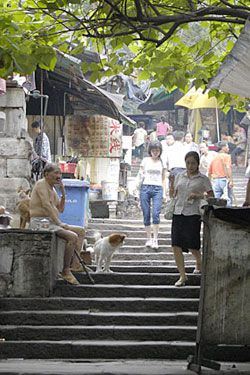|
"You had to take up the best spot where you anticipated the door would be right in front of you when a bus pulled in," Hu recalled. "Parents used to squeeze us kids into the bus through its windows to grab seats before others. It was even worse during the hot, smelly summers when passengers were packed in like sardines."
Memory II: Two cableways
 |
|
Two cableways (COURTESY OF HU FEI) |
The Yangtze River Cableway was put into operation in 1982, followed by Jialingjiang River Cableway in 1987. At that time, they provided the fastest and most convenient links between the three parts of Chongqing separated by the two rivers. It took a few minutes to cross the river on the cableway, one hour faster than by bus. It was also a joy to shuttle between the banks in a cable car with an amazing bird's-eye view of the mountainous city.
In 1997, Chongqing was designated as a municipality directly under the Central Government. The construction of modern transportation, as part of city development, has since been speeding up. Nowadays, people there travel in comfort by bus, taxi, light-rail train, private car and soon by subway. Vehicles no longer wait in long queues for ferries, thanks to the highways and bridges built in recent years that span the two rivers.
As a result, the two cableways have been preserved as a symbol of the city more than a favored mode of transportation, Hu told Beijing Review. But the cableways and gas-bag buses should be remembered, for they were an important part of life and played their due roles in the past.
Memory III: High chimneys
 |
|
A high chimney in Chongqing (COURTESY OF HU FEI) |
A forest of high chimneys emitting thick smoke was a typical picture of the heavy-industry city of Chongqing. Hu expresses nostalgia for the chimneys in his caricatures—watching his parents leave home, a small boy cries; pointing to the big chimneys in the distance, his grandmother tells him his parents are working just over there. At dusk, the boy stands outside, anxiously gazing at buses returning from the direction of the chimneys and expecting his parents.
Life changed in the late 1980s when China underwent the transition from a planned economy to a market-oriented one. Numerous workers lost their jobs due to the bankruptcy or restructuring of their factories. Hu's mother was among those laid-offs and his father chose to start a business.
Twenty years ago, the air was severely polluted in Chongqing. Hu remembered his white shirt would be spotted with black pollutants after he walked near the factories when it was drizzling. Today, the air quality is remarkably better, with most high-polluting factories replaced by environmentally-friendly plants and apartment buildings.
"Although most chimneys have been removed, they are something unforgettable in my childhood," Hu said.
Memory IV: 18 Stairs
 |
|
The 18 Stairs (COURTESY OF HU FEI) |
In Chongqing, there is a century-old flight of flagstone stairs called the 18 Stairs. It connects the prosperous northern part and undeveloped southern part of the city. In Hu's eyes, the 18 Stairs represent the original local lifestyle, like the hutongs in Beijing.
Elderly residents in the area live in suspension cottages built with bamboo chips and mud. They get up before dawn to make the fire for breakfast, then play cards or chat with neighbors in teahouses, sipping thick tuo tea—a bowl-shaped compressed mass of tea leaves.
From Hu's point of view, the traditional lifestyle might be out of tune with the fast pace of life in modern society, but it is an important part of local culture. "The 18 Stairs will be demolished very soon to make room for a subway exit. But they will remain in our memory," he told Beijing Review.
"With my cartoons, I wish to tell our descendants what our city and life were like in the old days," Hu said. "Having disappeared or disappearing, they are parts of history that belong to each of us and our hometown." | 
